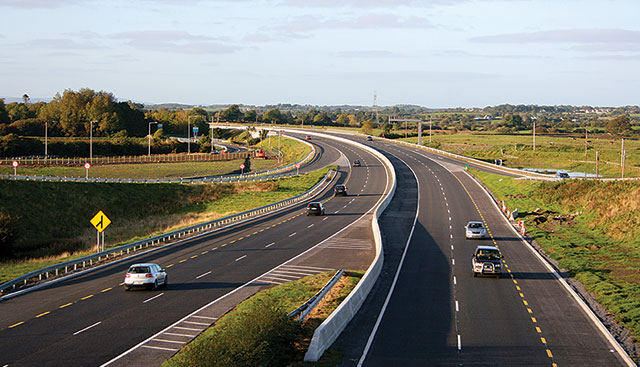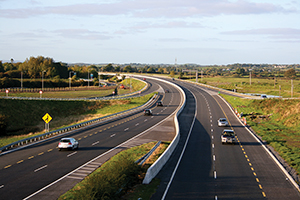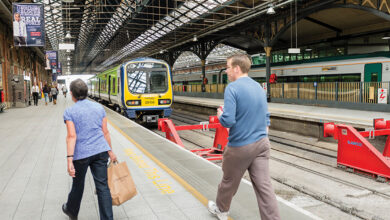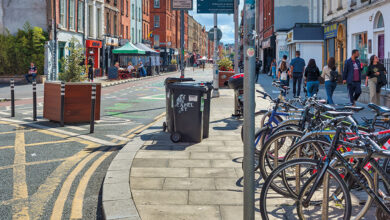Shaping Ireland’s land transport network

The Head of the Public Transport Investment Division, Ethna Brogan explains how the Capital Investment Plan 2016-2021 will impact upon public transport and road network investment.
Published last September, the Capital Investment Plan 2016-2021 sets out the state’s investment plans over the next six years. However, recognising the significant lead in times for many transport projects, the transport element of the plan covers the next seven years. Of the €10 billion allocated to the Department of Transport, Tourism and Sport, €9.6 billion has been allocated for transport investment.
 Of this €9.6 billion, roads will receive €6 billion of investment with public transport receiving €3.6 billion. As the Head of the Public Transport Investment Division, Ethna Brogan is confident this funding will deliver the main objectives of the transport investment programme.
Of this €9.6 billion, roads will receive €6 billion of investment with public transport receiving €3.6 billion. As the Head of the Public Transport Investment Division, Ethna Brogan is confident this funding will deliver the main objectives of the transport investment programme.
The main objectives of this programme are to develop and maintain transport networks to the required standard to ensure the safe and efficient movement of people and freight, to add appropriate capacity to the network to meet growth in demand and to encourage modal shift to ensure transport makes a contribution to Ireland’s climate mitigation targets.
Evidence based targets
While Brogan acknowledges that these targets may sound aspirational she is adamant they have a sound evidence base, framed by the department’s Strategic Framework for Investment in Land Transport (SFILT). The framework was developed following the financial crisis when capital transport funding fell to historically low levels of 0.5 per cent of GDP. In this context, the SFILT set out to determine the appropriate levels of investment and define the priorities and principles to guide allocation of future investment. The results were published last summer.
The first of the framework’s recommendations was to restore investment levels to 1.15 per cent of GDP. The primary focus of this framework is on achieving steady state maintenance of the strategically important elements of the existing land transport networks in an effort to keep the system in an adequate position and condition for the efficient transport of people and goods. The second priority is to address urban congestion and the third is to maximise the contribution of land transport networks through targeted investments aimed at improving connectivity and increasing the attractiveness of public transport.
“Having completed the SFILT was important for the department as it entered into negotiations with DPER on the new capital plan,” said Brogan. “It provided an evidence based estimate of the annual funding requirements for the land transport network to maintain infrastructure at steady state levels which was an important starting point for the department in those negotiations when there are so many competing demands for funding.
Investment
Of the €6 billion allocated for investment in the road network over the period of the plan, €4.4 billion is required for steady state maintenance of existing national, regional and local roads. “This steady state investment is important,” states Brogan. “The implications of failing to maintain the network is evident in the current degradation of parts of the network and the cost of repairing these areas is ultimately higher than the cost of steady state investment.”
A significant amount of the fund (€600 million) has also been allocated to the development of PPP road projects including the N17/18 Gort to Tuam scheme and the N25 New Ross By-Pass. A further €860 million will fund priority projects targeting the removal of bottlenecks such as the M7 Naas-Newbridge road widening scheme and the N59 Moycullen By-Pass. Similarly, a number of schemes are targeted at facilitating industry and employment such as the improvement of the road network at Grange Castle Business Park.
Turning her attention to public transport investment, Brogan notes how the programme upholds the principles of the government’s smarter transport policy and how the department worked closely with the NTA when revising the investment plan. As a result, €2.6 billion of the €3.6 billion to be invested in public transport will be spent on maintenance and asset renewal while the other €1 billion will be spent addressing congestion and bottlenecks. “Towards the end of the seven year plan we will have scope to start some major new projects,” states Brogan. “But in the earlier years we are looking at completing the projects already underway and maintaining steady state levels.”
With regards to the rail network, the infrastructure management contract of the heavy rail network is managed by Irish Rail. The investment required to maintain a steady state accounts for almost 20 per cent of total steady state costs for the entire inland transport network and while admitting the network is not being maintained to this standard at present, Brogan is adamant that this level of investment will be reached over the next seven years.
With increasing passenger numbers, the bus is the workhorse of the public transport system. “The bus is, and will remain the key public transport mode in the greater Dublin area and across the state,” notes Brogan. “Investment has been targeted at fleet replacement and capacity enhancement, infrastructure development and upgrading a small number of routes to Bus Rapid Transit but there would be little point in making this investment if buses are going to sit on congested city streets, so investment will also be targeted at improving bus network infrastructure.”
Reflecting on the overall impact of the Capital Investment Plan on the land transport network, Brogan acknowledges that funding in the immediate future remains constrained but by 2020 the funding will allow steady state levels to be reached across the network. “Thankfully the expanded time horizon that the department secured in its negotiations with DPER will enable us to make progress on some new projects to support competitiveness and economic growth,” says Brogan “Importantly, it will also help us in our efforts to meet our climate change targets and commence construction on some new major projects including Metro North in the final years of the plan.”





